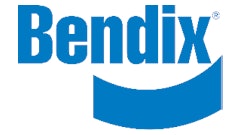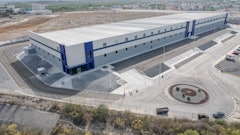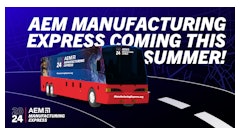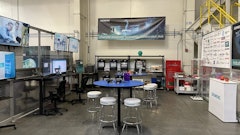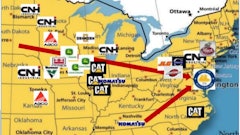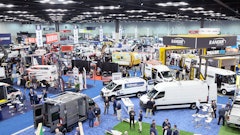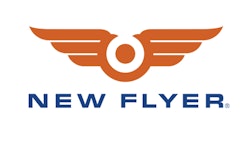
New Flyer Industries Inc., the leading manufacturer of heavy-duty transit buses in Canada and the United States, has announced its results for the 13-week period ended December 28, 2014 (2014 Q4) and the 52-week period ended December 28, 2014 (Fiscal 2014).
Operating Results
Bus deliveries increased during 2014 Q4 as compared to 621 EUs delivered during the previous quarter. The total bus inventory for the company at December 28, 2014 of 358 EUs, decreased 41 EUs from the previous quarter.
- The increase in 2014 Q4 bus revenue resulted from a 7.1% increase in total bus deliveries and a 0.3% increase in average selling price.
- Revenue from bus manufacturing operations for Fiscal 2014 increased 15.0% compared to the 52-week period ended December 29, 2013 (Fiscal 2013). The increased deliveries during Fiscal 2014 were primarily as a result of the acquisition of NABI-Optima Holdings Inc. (NABI) effective June 21, 2013 and the resulting increased number of EUs produced per week in 2014 Q4 versus the 13-week period ended December 29, 2013 (2013 Q4). The increase in average selling price is the result of changes in the product sales mix. The average selling price can be volatile when comparing quarters as a result of sales mix and propulsion type.
- The increase in revenue from aftermarket operations during 2014 Q4 of 22.6% is primarily a result of increased volumes and the incremental revenue from the Chicago Transit Authority (CTA) mid-life overhaul program. The increase in aftermarket operations revenue during Fiscal 2014 is primarily a result of increased volumes, CTA mid-life overhaul program and the acquisitions of both the Orion and NABI aftermarket parts businesses in 2013.
- The 2014 Q4 bus manufacturing operations Adjusted EBITDA decrease was expected as management had previously provided guidance about lower than average margins. 2014 Q4 Adjusted EBITDA also decreased as a result of an accounting provision made for the expected payment of $2.4 million regarding performance share units.
- Bus manufacturing operations Adjusted EBITDA for Fiscal 2014 was 5.1% of bus revenue, a decrease compared to 6.5% of bus revenue during Fiscal 2013. Management has continued its efforts to recover margins through cost reductions and improved labor efficiency to mitigate the impact of the lower margins on planned production throughout Fiscal 2014. As well, the company recognized $11.7 million of investment tax credits (ITCs) in Fiscal 2014 as compared to $8.1 million in Fiscal 2013. At December 28, 2014 only $0.2 million of ITCs remain unapplied. The related tax credit program has ended and has not been renewed.
- 2014 Q4 and Fiscal 2014 aftermarket operations Adjusted EBITDA increased compared to the 2013 respective periods, primarily a result of increased volumes and margins which have more than offset lower than average margins generated by the CTA midlife overhaul program. Also, Fiscal 2014 Adjusted EBITDA increased due to a full year of earnings from the acquisition of the NABI and the Orion aftermarket parts businesses when compared to Fiscal 2013.
The company reported net earnings of $7.4 million in 2014 Q4 representing a decrease compared to net earnings of $13.7 million during 2013 Q4. Earnings from operations decreased in 2014 Q4 compared to 2013 Q4 primarily as a result of lower than average bus margins and $1.0 million of accelerated amortization expense, as a consequence of the company’s plan to rationalize NABI’s products to a common Xcelsior platform. The estimated useful lives of the related equipment and intangible assets have been adjusted to align with the final production dates and depreciation and amortization has been accelerated accordingly. The company’s net earnings per common share (Share) in 2014 Q4 were $0.13, a decrease from net earnings per Share of $0.25 generated during 2013 Q4.
Fiscal 2014 net earnings of $26.7 million remained substantially unchanged from Fiscal 2013, however Fiscal 2014 net earnings were negatively impacted by the $4.8 million impairment loss and the $7.8 million increase in amortization. Net earnings per Share in Fiscal 2014 of $0.48 decreased compared to $0.52 generated during Fiscal 2013 primarily as a result of having more Shares outstanding after issuing 11.1 million Shares throughout Fiscal 2013.
Liquidity
Management believes that sufficient Free Cash Flow will be generated to maintain the current annual dividend rate of $0.585 per Share. The Free Cash Flow payout ratio was 49.6% in Fiscal 2014 compared to 68.1% during Fiscal 2013.
As at December 28, 2014, there were $40.0 million of direct borrowings and $19.3 million of outstanding letters of credit related to the $115.0 million revolving credit facility.
Market Size and Share
Management estimates that heavy-duty bus manufacturers delivered approximately 5,100 EUs in 2014 to Canadian and U.S. transit operators, which is a slight increase from the total number of estimated EUs delivered in 2013. This is consistent with the estimated range of deliveries over the last 15 years (from 4,000 EUs to 6,000 EUs).
Management estimates that New Flyer's actual market share of EUs delivered in Canada and the United States for Fiscal 2014 was approximately 48%, an increase from its estimated market share of 43% for Fiscal 2013. The increase was primarily as a result of the acquisition of NABI in June 2013 and the introduction of MiDi.
New Flyer’s aftermarket segment market share is believed to have grown to an estimated 33% in Fiscal 2014 from an estimated 28% from Fiscal 2013. Management is currently engaged in a strategic review of New Flyer’s aftermarket business to identify efficiencies through business and system synchronization to enhance performance and customer support.
Market and Business Outlook
The company’s Fiscal 2015 annual operating plan is focused on executing the phase out production of the NABI bus models from the Anniston, AL, facility and transition to the Xcelsior bus platform. The transition is proceeding in accordance with management’s plans and is targeted to be completed during the second half of 2015. Management expects the transition to allow for improvement in competiveness by leveraging combined bus volume, production and purchasing for greater efficiencies. Management further expects to streamline design, sourcing, and overhead for better product control. The transition is also anticipated to enable product enhancements and optimize aftermarket support to better serve customer needs and involves a transition to common information technology infrastructure. The company believes customers will benefit from the enhancements that result from its focus on a single heavy-duty platform.
Throughout the transition process, management expects to invest approximately $20.0 million in direct operating costs and capital expenditures to complete the transition, utilizing operating cash flow and current credit facilities. As of December 28, 2014, the company had incurred $3.1 million of costs. Management anticipates these direct operating and capital expenditures will be paid back through captured cost reductions and synergies within approximately two to three years. Currently, the annualized savings are $11.9 million.
Management believes pricing in certain types of bus competitions has normalized and expects that bus margins realized during Fiscal 2015 will be on average higher than those realized during Fiscal 2014. Management continues to pursue cost and overhead savings as a result of its decision to focus exclusively on the Xcelsior platform and its Operational Excellence initiatives. Management anticipates that bus margins for Fiscal 2015 should mitigate the loss of Adjusted EBITDA derived from the company’s ITCs, which were substantially all realized during Fiscal 2014.
The aftermarket parts revenue generated from CTA mid-life upgrade program represented 14.8% of the total aftermarket revenue during Fiscal 2014. This stream of revenue is expected to conclude by June 2015. Management forecasts core aftermarket parts revenue growth at approximately 5% during Fiscal 2015.
As at the date of this release, the company has filled approximately 80% of its Fiscal 2015 planned production schedule, which is similar to last year at this time. Fiscal 2015 however, has a higher production rate than the previous year. The New Flyer backlog and orders anticipated to be awarded by customers under new procurements are expected to enable the company to continue to operate at a corporate average line entry rate of approximately 51 EUs (including MiDi) per production week for Fiscal 2015 as the company executes on the rationalization of the NABI Bus product lines to the Xcelsior platform. Production rates may vary from quarter to quarter due to sales mix and the introduction of the Xcelsior in the Anniston, AL, facility.





